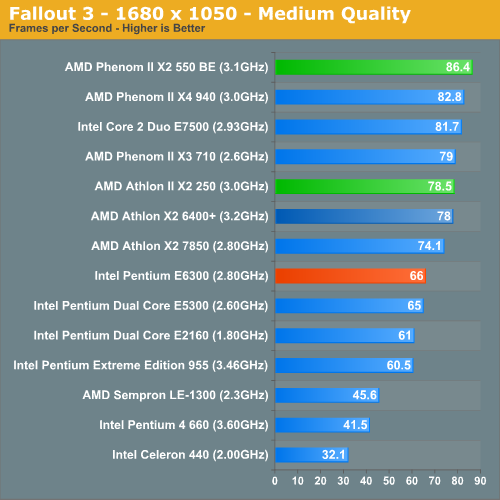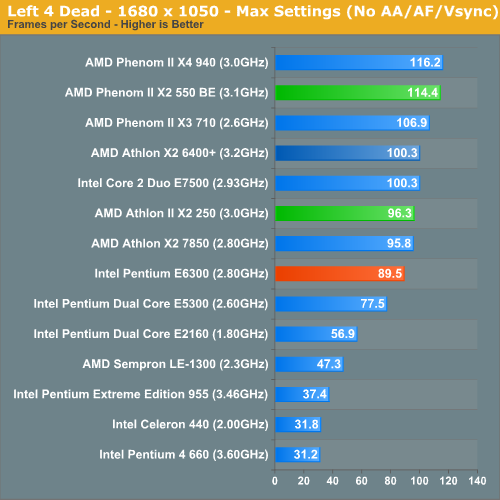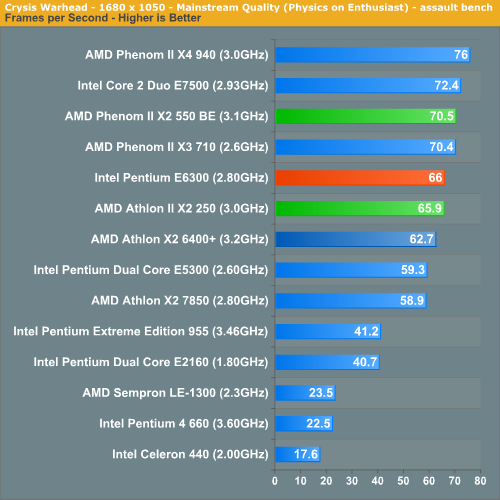The Athlon II X2 & Phenom II X2: 45nm Dual-Core from AMD
by Anand Lal Shimpi on June 2, 2009 12:00 AM EST- Posted in
- CPUs
Fallout 3 Game Performance
Bethesda’s latest game uses an updated version of the Gamebryo engine (Oblivion). This benchmark takes place immediately outside Vault 101. The character walks away from the vault through the Springvale ruins. The benchmark is measured manually using FRAPS.

Gaming performance clearly goes to the Athlon II X2 and the Phenom II X2. Because of its high clock speed and very high core-to-cache ratio, the Phenom II X2 550 is actually faster than the Phenom II X4 940 in this test. Note that Fallout 3 isn't particularly heavily threaded so the X4's additional cores don't do much good here.
Left 4 Dead

AMD continues to hold on to the gaming performance lead.
FarCry 2 Multithreaded Game Performance
FarCry 2 ships with the most impressive benchmark tool we’ve ever seen in a PC game. Part of this is due to the fact that Ubisoft actually tapped a number of hardware sites (AnandTech included) from around the world to aid in the planning for the benchmark.
For our purposes we ran the CPU benchmark included in the latest patch:

In the newer game engines we see the E6300 catching up to the Athlon II X2 250. The old Pentium 4 660 starves our testbed's GeForce GTX 280 for data; it's horrendously slow.
Crysis Warhead











55 Comments
View All Comments
TA152H - Tuesday, June 2, 2009 - link
I agree with almost everything you say, I only have a small caveat.Intel chips will suffer much less from this than AMD, since they have an inclusive cache architecture, and can readily read the information from the L3 cache. I still think AMD has an exclusive cache arrangement, which I really think they should change with regards to the L3 cache for reasons just like the one you mention.
For what's it's worth, Microsoft screwed Intel 14 years back when the Pentium Pro was released. Naturally, Intel got the blame for having miserable 16-bit performance (it was related to segmentation, which was part of all the 16-bit modes, and technical, even 32-bit mode even though it was transparent), because Microsoft told them the world will be 32-bit by then. Of course Windows 95 had a lot of legacy code, and Windows NT, which we called "Not There" at the time, was about as common as a 20 year old virgin in western Europe. So, Intel took the blame, just like AMD is now, despite, once again, Microsoft's incompetence.
Really, if you think about it, the ability to clock the processors differently could be a very useful features, except for the fact Winblows can't use it properly.
Good
TA152H - Tuesday, June 2, 2009 - link
First, I like seeing the Pentium 4s in the benchmarks, it was kind of interesting. They did better than I thought they would, and it makes me even more curious what they would be like on 45nm, since their clock speeds would probably be astronomical (since 45nm has much better power characteristics, and the clock speed limiter on the Pentium 4 was power use/heat).But, anyway, why not use the Pentium 4 670 (3.8 GHz), or Pentium EE 965 Extreme Edition (3.73 GHz) processors? Why use the next to fastest ones?
Don't get me wrong, it was still informative, but I would have liked to see the fastest measured against today's processors, not one step removed. Even so, it was nice to see them, so it's just a minor complaint. I'm looking forward to seeing the Nano.
strikeback03 - Wednesday, June 3, 2009 - link
Might not have had any around. Figure the "best of breed" were the most likely to be either sold or go in a system for some family member when they were no longer needed for comparison duties.ShangoY - Tuesday, June 2, 2009 - link
I am curious as to why the current cheapest Intel quad core were not included in the benches yet you bothered to go grab the previously $999 Pentium 4 and then also included the Phenom X4 940.Gary Key - Tuesday, June 2, 2009 - link
http://www.anandtech.com/bench/default.aspx?b=2">http://www.anandtech.com/bench/default.aspx?b=2 - You can compare them here.Kenzid - Tuesday, June 2, 2009 - link
Does any body know why AMD transistor density is very low compare to Intel? Is this because of Intel High K metal process or the architechture?Goty - Tuesday, June 2, 2009 - link
It's more than likely due to the fact that Intel has much higher cache densities than AMD does. It probably had very little to nothing to do with the actual process (well, beyond the geometry size, that is).TA152H - Tuesday, June 2, 2009 - link
What are you basing that on?Typically, cache is very dense, so you will notice transistor count increasing disproportionately to size as you add cache.
With respect to the Athlon II X2 being larger than the Penryn, that's not really a bad thing, since it does more too; the Penryn needs a memory controller on the chipset that the Athlon II does not.
Kenzid - Tuesday, June 2, 2009 - link
Based on above die size chart. Core2Duo 107mm2 and 410million transistors while Athlon II has only 234million transistors on 117mm2. It's almost half of the number of Intel used on theirs. IMC take that much space?TA152H - Tuesday, June 2, 2009 - link
Well, take a look at the Pentium version, and you'll see the what I was saying about the cache. We both can agree it's the same core, but one has a larger cache.The Pentium is 82 mm2, with 228 million transistors, with a 2.064 megabytes of cache (L1 + L2). But, since 1 megabyte is disabled, it's really 3.064, like the other Wolfdale's have. The 6 MB version of the Core 2 is 107 mm2 with 410 million transistors.
So, you can see that adding 3 MB of cache increased the transistor count by 182 million, but the size by only 25 mm2. Or, in other words, it increased transistors by about 80%, but size by about 31%. So, cache does increase transistor count disproportionately to die size.
Oh, and yes, the IMC is quite large. You can view some of the pictures of the CPU die to see it, but it's far from insignificant in size.